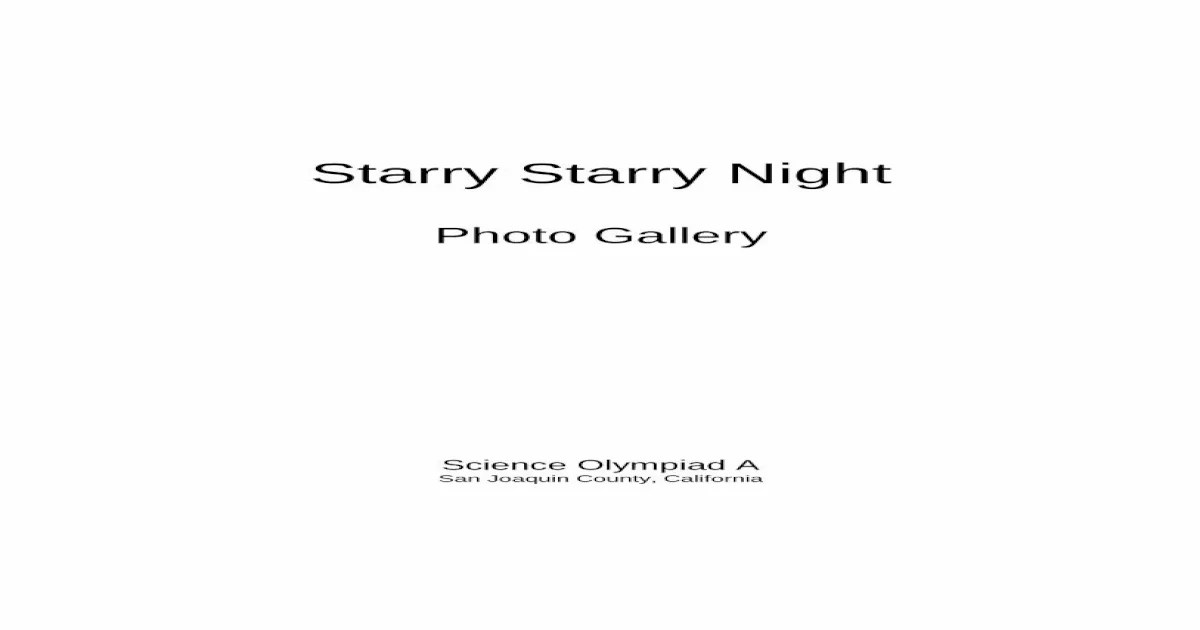The “Starry Starry Night Science Olympiad” sets the stage for this enthralling narrative, offering readers a glimpse into a story that is rich in detail and brimming with originality from the outset. This captivating exploration delves into the profound connection between art and science, using Vincent van Gogh’s iconic masterpiece as a prism through which to unravel the mysteries of the cosmos.
The second paragraph provides a descriptive and clear overview of the topic, establishing the significance of van Gogh’s painting and its role in inspiring scientific inquiry. It explores the astronomical phenomena depicted in the artwork and the scientific principles that govern the movement and appearance of celestial bodies.
The Artistic Origins of Starry Starry Night: Starry Starry Night Science Olympiad

Vincent van Gogh, a Dutch post-impressionist painter, created “Starry Starry Night” in 1889. The painting depicts the view from his window at the Saint-Paul-de-Mausole asylum in Saint-Rémy-de-Provence, France. “Starry Starry Night” is characterized by its vibrant colors, swirling brushstrokes, and expressive depiction of the night sky.
Significance within van Gogh’s Oeuvre
The painting is considered one of van Gogh’s most iconic works and exemplifies his unique artistic style. It combines elements of realism, such as the accurate depiction of the village and church, with elements of expressionism, such as the exaggerated and distorted forms of the cypress tree and the stars.
Symbolism and Techniques
The painting is rich in symbolism. The cypress tree is often interpreted as a symbol of death, while the stars represent hope and eternity. The swirling brushstrokes create a sense of movement and energy, suggesting the dynamism of the night sky.
Van Gogh’s use of complementary colors, such as blue and orange, enhances the painting’s visual impact.
Scientific Exploration of the Night Sky

The night sky depicted in “Starry Starry Night” is scientifically accurate. The painting shows the constellations of Ursa Major and Ursa Minor, as well as the planet Venus.
Astronomical Phenomena
The movement of the stars and planets is governed by the laws of physics. The Earth’s rotation causes the stars to appear to move across the sky from east to west. The planets, on the other hand, orbit the Sun and therefore appear to move relative to the stars.
Instruments in Astronomy
Astronomers use telescopes and other instruments to study the night sky. Telescopes allow astronomers to magnify distant objects, while other instruments, such as spectrometers, allow astronomers to analyze the light emitted by stars and planets.
The Intersection of Art and Science

“Starry Starry Night” combines artistic expression with scientific observation. Van Gogh’s depiction of the night sky is both visually stunning and scientifically accurate.
Art Inspiring Science
Art can inspire scientific inquiry by providing new perspectives on the world. “Starry Starry Night” has inspired astronomers to study the night sky in new ways and has helped to raise awareness of the beauty and wonder of the universe.
Science Inspiring Art
Science can also inspire art. Scientific discoveries can provide artists with new ideas and perspectives. For example, the discovery of the planet Pluto inspired van Gogh to paint “The Starry Night.”
Imagination and Creativity in Science
Imagination and creativity play an important role in scientific discovery. Scientists need to be able to imagine new possibilities and to think outside the box. “Starry Starry Night” demonstrates the power of imagination and creativity in both art and science.
The Impact of “Starry Starry Night” on Science Education

“Starry Starry Night” has been used in science education programs to teach students about astronomy and the nature of science.
Examples in Science Education
The painting has been used to illustrate concepts such as the movement of the stars and planets, the use of telescopes, and the importance of imagination and creativity in science.
Understanding Astronomy
“Starry Starry Night” can help students to understand the vastness and beauty of the universe. The painting can also help students to appreciate the role of science in exploring and understanding the natural world.
STEM Learning and Engagement, Starry starry night science olympiad
The painting can enhance STEM learning and engagement by showing students how art and science can be interconnected. “Starry Starry Night” can also help students to develop their critical thinking skills and their appreciation for the beauty of the natural world.
FAQ Resource
What is the significance of “Starry Starry Night” in the context of science education?
The painting has been used extensively in science education programs to help students understand astronomy and the nature of science. It provides a tangible connection between art and science, demonstrating how artistic expression can inspire scientific inquiry and vice versa.
How does “Starry Starry Night” foster a deeper understanding of astronomy?
The painting depicts various astronomical phenomena, such as stars, planets, and the Milky Way galaxy. By analyzing the painting, students can gain insights into the movement and appearance of celestial bodies, as well as the vastness and beauty of the universe.
What is the role of imagination and creativity in scientific discovery?
Imagination and creativity play a crucial role in scientific discovery by allowing scientists to envision new possibilities and explore unconventional ideas. “Starry Starry Night” exemplifies how artistic expression can spark scientific curiosity and inspire new ways of thinking about the world.

